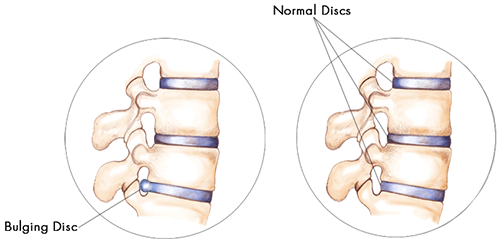Exercise and stretching are some of the first things people do for pain associated with a bulging disc in the spine. However, for some, bulging disc symptoms can be painful and interfere with everyday living. Left untreated, a bulging disc can lead to further spinal issues including nerve root or spinal cord compression.
A bulging disc occurs when the inner portion, the gel-like nucleus pulposus, of an intervertebral disc protrudes from the outer wall of the disc, the annulus fibrosis. The bulge can put pressure on the nerve roots, which then leads to radiating pain in the upper and lower extremities.
Trauma, such as an auto accident, can cause a bulging disc. But the condition most commonly occurs due to aging. The dehydration of the intervertebral discs and the poor posture it causes can actually weaken the outer wall of the spinal discs and in time, makes the displacement of the material in the nucleus much more likely.
Some symptoms of a bulging disc may include:
- Pain when bending or turning
- Pain made worse with coughing or laughing
- Muscle spasms
- Severe low back pain, leg pain, neck pain or arm pain
The majority of the pain a person will experience will be determined by where the disc is bulging. If it is in the upper region of the spine, they’re more likely to have neck or arm issues. A bulging disc in the mid-to-lower spine will lead to pain in the lower back and the lower extremities, including the legs and/or feet.
If you are dealing with a bulging disc, conservative treatments are the first option to consider. There are several bulging disc exercise options and stretches that could help provide some relief.
The Twisting Stretch
Lie on your back with your knees bent and pressed together. Tighten your core and slowly bring both knees down toward your right side. Hold this stretch for 10 seconds. Repeat this movement with your knees being pushed down to your left side and hold for 10 seconds. You can repeat the twisting stretch up to 3 times a day.
The Bridge
Lie on your back with your knees bent and feet hip-width apart. You should then raise your hips off the ground while keeping your feet firmly planted. The goal is to achieve a straight line from your shoulders through your knees. Hold this position for 10 seconds and then slowly lower your bottom back down. It’s okay if you are unable to hold this position for 10 seconds, hold it as long as you can and then repeat it 3 times.
Knee to Chest Stretch
Lie on your back with your knees bent. Slowly bring both your knees toward your chest and use your hands to hold them in place. Hold this position for a few seconds; you should feel a stretch in your lower back. You can also perform this exercise with one leg at a time.
Low Impact Cardio
Low-impact aerobic exercises can not only help you stay active, but also help subside some of the pain associated with a bulging disc. Low impact cardio may include water exercises, walking or stationary biking.
When you are suffering from a bulging disc, exercise might be the last thing on your mind. However, it is important to keep active and build a strong core as it can help protect your back from further injury.
If conventional methods are not helping and you believe that your condition is worsening, contact us. You may be a candidate for our targeted and patented Bonati Spine Procedures that can help you get back on your feet. To learn more call 855-267-0482 or complete our contact form here.

